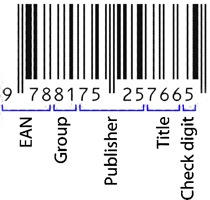By Joe Moore
The authors here at TKZ blog write in the mystery/thriller genre. We cover the gamut of action and suspense themes. All our books contain totally different stories and different styles from different perspectives and voices. We are individual writing original fiction.
But there’s one thing we all have in common with each other and every other published writer. Somewhere on the cover of our books is a number (usually displayed with a bar code) called the International Standard Book Number (ISBN). Recently, someone asked me what the number meant, besides just identifying the specific book. I had no idea, so I went searching for a answers.
Here’s what I found.
 An ISBN is assigned to each edition and variation (except reprints) of a book.
An ISBN is assigned to each edition and variation (except reprints) of a book.
The ISBN system is universal. So anyone with knowledge of the numbering system can decipher what it means including where it was published.
Up until January 1, 2007, ISBN’s contained 10 digits. Now they have 13.
An ISBN-13 is made up of five parts usually separated by hyphens. The first part is 978 to comply with something called the GS1 global standard.
The second part is a group or country identifier. English speaking countries start with 0 or 1. French with 2. German with 3. Japan with 4. Here’s a list of all the group/country identifiers.
The next part is the publisher’s number. Publishers usually purchase blocks of ISBN’s.
The publisher’s numeric title of the book is the next number.
The final number is called a “check digit” used for error detection and to validate the ISBN. It is always a single digit, so if the formula used to determine the check digit produces a 10, it is designated by the Roman numeral X.
Here’s some additional info on ISBNs.
A new ISBN number is required if you change the title on a reprint, make a substantial revision (approximately 15-20% of the text), and change the format or binding such as going to audio or hard cover to paperback.
There’s no need to use a new ISBN on additional printings or if the price changes.
You can never reuse an ISBN on another book if the first goes out of print. Plus, even if a book is declared out of print, many booksellers such as Amazon are involved in the selling of used books. So the title and ISBN can remain active long after the publisher has stopped printing.
Although it’s a dry topic, the ISBN is a common thread that binds all published authors together. And like so many other elements in the publishing world, we should all be aware of what that little number means on the back of our books.
~~~~~~~~~~~~~~~~~~~~
Coming Sunday, June 21, Paul Kemprecos tells us what it’s like to collaborate with Clive Cussler. And future Sunday guest bloggers include Robert Liparulo, Linda Fairstein, Julie Kramer, Grant Blackwood, and more.

Thanks, Joe. It’s nice to hear about an industry number that isn’t related to sales, returns or trendlines.
Interesting. I had no idea what all the numbers represented. Thanks for sharing.
Elizabeth
Mystery Writing is Murder
Something that isn’t emphasized in this post about ISBN numbers is that the number of digits that identify the publisher and book number vary.
The 13-digit ISBN numbers basically add the EAN prefix and the check digit changes. However, sometimes it is easiest to visualize with a 10-digit version.
Of the 10 digits the first is a language group and the last is the check digit. The remaining 8 are left for assigning publishers and books.
A very large publisher issues lots of books over a period of years. However, there are very few publishers on this scale. Hence a publisher like Macmillan had a publisher code of 02 which left 6 digits for assigning up to a million books 000000-999999.
Mid-size publishers might have 3 or 4 digits to identify themselves and 5 or 4 digits to identify the books.
Very small publishers, of which there are many, may have as many as 7 digits to identify the publisher and as little as a single digit to list up to 10 books.
This separation is easier to spot when the dashes are included in representing the ISBN. The modern practice of having an unbroken string of 10 or 13 digits for web sites hides this bit of data.
As a collector and bookseller I can sometimes use this information to get a sense of how many copies the publisher likely issued. It’s not absolute but large publishers tend to issue more copies of their books, especially if they are mass-market rather than library oriented.
As publishers merge or buy one another the new entity inherits the ISBN publisher block numbers from the old firms. It may be cynical but sometimes I wondered if some of the mergers were motivated by this “real estate.”
ISBNs were generally added to books around 1967. There was a predecessor called the SBN that did not have the language group digit. If you see an ISBN for an older title, it is a post-1966 edition.
James Keeline
Fascinating. My only sort-of-publishing foray is a few books on Lulu that don’t have ISBNs ’cause they’d make me price them way out of the market if I did. They’re on Amazon now with ASINs, which I suppose is Amazon’s imitation ISBNs.
Thank s everyone for your comments. James, a big thanks for the additional clarification. Sheila, your guess is correct–the ASIN is unique to Amazon.